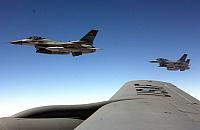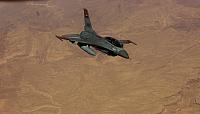Fighter Jet News
F-16 Fighting Falcon News
USAF refuelers train with Egyptian F-16 pilots
November 8, 2007 (by
SSgt. Amy Abbott) -
US Air Force reservists are conducting two weeks of air-refueling missions in Egypt with F-16 pilots from the Egyptian air force.
"I think this is a great opportunity for the entire U.S. Air Force," said Lt. Col. Al Oliver, the mission director and a tanker refueling scheduler with 4th Air Force at March Air Reserve Base, Calif. "Egypt is one of our strongest allies in the region and an opportunity to work with them affects much more than just March ARB. It gives people a good opportunity to see how our Air Force operates and allows us to really be ambassadors for America ."
KC-135 Stratotanker pilots and boom operators from the 336th Air Refueling Squadron fly missions in which Egyptian F-16 and Mirage 2000 pilots practice air-refueling tactics. Egypt has more than 200 F-16s and Air Force aircrews provides its pilots with in-flight refueling training and other tactics so they can operate their aircraft more efficiently.
Egyptian air force requirements consist of refueling training for their pilots every six months. Due to high operational climate in the region, Colonel Oliver said, tanker availability is limited and it has been more than a year since their last training. To maximize the refuelers' time in Egypt, aircrews have kept a rigorous schedule. They have flown both day and night sorties and conducted 40 to 50 refuelings per flight, many more than a typical training mission.
In mid-air refueling, connecting pilots request permission from the tanker pilot to move into a pre-contact position. They then move from the right observation point of the refueler to the tail end and begin direct communication with the boom operator on another radio frequency.
"This is not easy. It is probably the most challenging mission for our booms," said Colonel Oliver. "They are under the most pressure to make sure this operation goes smoothly."
The boom operator, through verbal communication and a series of lights, directs the connecting pilot into an envelope of space at the tail end of the aircraft where they can connect the hose and transfer fuels, sometimes up to 40,000 pounds per sortie. The two aircraft fly connected through the process with only about 20 feet between them.
"You can get killed if the receivers do not listen or come in too quickly," said Tech. Sgt. John Bradbury, a boom operator with the 336th ARS who had 67 contacts on one sortie over Egypt.
The boom operator has to make a split second decision if the situation is too dangerous to either disconnect contact with the receiving aircraft or, in some cases, call a "break away," in which the tanker pilot immediately responds by pulling the tanker out and up as fast as possible.
"(It's) when the two aircraft are getting ready to collide, when it is really unsafe and could be catastrophic," Sergeant Bradbury said.
One of the more challenging aspects for boom operators is the language barrier. Though Egyptian pilots understand basic verbiage, the boom operator must speak slowly and clearly.
On the ground, Egyptian air force representatives get feedback from Colonel Oliver. After each sortie and a minimum of twice a day, they discuss training information and how the receivers can improve.
"(The feedback) has been extremely, extremely positive," Colonel Oliver said. "They are very happy that the instructor boom has been able to give them information in real time. Often, because of infrequent training, the receivers require quick reviews and (Egyptian air force) General Hesham Sabry (in charge of air division training) has been very, very appreciative. This goes back to the highly skilled boom operators that we brought."
In addition to pilots, boom operators and a flight surgeon from the 336th ARS, the deployed package also consists of several maintenance troops from the 752nd Aircraft Maintenance Squadron at March ARB, a contingent of Ravens for security from the 315th Security Forces Squadron at Charleston Air Force Base, S.C. and the 349th SFS at Travis AFB, Calif.
"We basically brought the best of the best because we wanted to put our finest foot forward," said Lt. Col. Phil Anderson, a pilot with the 336th ARS and the crew commander for the mission. "The proficiency of the troops brought here is top notch and I think it shows in the mission completion rate we have had, especially the maintainers. So far we have managed to keep the one airplane we have flying through what so far has been a very rigorous schedule."
The technicians from the 752nd AMXS are responsible for maintaining the aircraft, refueling it and scheduling work on it without the support they would typically have on a military base. They have worked alongside Egyptian military members on the flightline, with fuel truck drivers and dealt with people supplying their power units and any equipment they may need.
"I think they are surprised over here that enlisted people have as much responsibility as we do," said Master Sgt. Jerry Merrill, 752nd AMXS crew chief. "Trips like this are very much needed because they go a long way to promote goodwill between the two countries, especially our militaries. They have impressions about us and we have impressions about them, but once we get together, we find out that we are not too much different."
It took more than nine months to plan out the details of the assignment. Colonel Oliver accepted it and has worked with the embassy here. Due to intense security measurements the groundwork involved more than the average amount of coordination. He said he pushed for the assignment because he understood its significance to a broad audience.
"It's not just Egypt, it is everyone who are our allies in this part of the world, who are our friends. We want to work with them, we want to commit to them that we are there and vice versa," Colonel Oliver said. "We are like ambassadors to them. If they can count on us when we're needed, then we certainly can count on them.
KC-135 Stratotanker pilots and boom operators from the 336th Air Refueling Squadron fly missions in which Egyptian F-16 and Mirage 2000 pilots practice air-refueling tactics. Egypt has more than 200 F-16s and Air Force aircrews provides its pilots with in-flight refueling training and other tactics so they can operate their aircraft more efficiently.
Egyptian air force requirements consist of refueling training for their pilots every six months. Due to high operational climate in the region, Colonel Oliver said, tanker availability is limited and it has been more than a year since their last training. To maximize the refuelers' time in Egypt, aircrews have kept a rigorous schedule. They have flown both day and night sorties and conducted 40 to 50 refuelings per flight, many more than a typical training mission.
In mid-air refueling, connecting pilots request permission from the tanker pilot to move into a pre-contact position. They then move from the right observation point of the refueler to the tail end and begin direct communication with the boom operator on another radio frequency.
"This is not easy. It is probably the most challenging mission for our booms," said Colonel Oliver. "They are under the most pressure to make sure this operation goes smoothly."
The boom operator, through verbal communication and a series of lights, directs the connecting pilot into an envelope of space at the tail end of the aircraft where they can connect the hose and transfer fuels, sometimes up to 40,000 pounds per sortie. The two aircraft fly connected through the process with only about 20 feet between them.
"You can get killed if the receivers do not listen or come in too quickly," said Tech. Sgt. John Bradbury, a boom operator with the 336th ARS who had 67 contacts on one sortie over Egypt.
The boom operator has to make a split second decision if the situation is too dangerous to either disconnect contact with the receiving aircraft or, in some cases, call a "break away," in which the tanker pilot immediately responds by pulling the tanker out and up as fast as possible.
"(It's) when the two aircraft are getting ready to collide, when it is really unsafe and could be catastrophic," Sergeant Bradbury said.
One of the more challenging aspects for boom operators is the language barrier. Though Egyptian pilots understand basic verbiage, the boom operator must speak slowly and clearly.
On the ground, Egyptian air force representatives get feedback from Colonel Oliver. After each sortie and a minimum of twice a day, they discuss training information and how the receivers can improve.
"(The feedback) has been extremely, extremely positive," Colonel Oliver said. "They are very happy that the instructor boom has been able to give them information in real time. Often, because of infrequent training, the receivers require quick reviews and (Egyptian air force) General Hesham Sabry (in charge of air division training) has been very, very appreciative. This goes back to the highly skilled boom operators that we brought."
In addition to pilots, boom operators and a flight surgeon from the 336th ARS, the deployed package also consists of several maintenance troops from the 752nd Aircraft Maintenance Squadron at March ARB, a contingent of Ravens for security from the 315th Security Forces Squadron at Charleston Air Force Base, S.C. and the 349th SFS at Travis AFB, Calif.
"We basically brought the best of the best because we wanted to put our finest foot forward," said Lt. Col. Phil Anderson, a pilot with the 336th ARS and the crew commander for the mission. "The proficiency of the troops brought here is top notch and I think it shows in the mission completion rate we have had, especially the maintainers. So far we have managed to keep the one airplane we have flying through what so far has been a very rigorous schedule."
The technicians from the 752nd AMXS are responsible for maintaining the aircraft, refueling it and scheduling work on it without the support they would typically have on a military base. They have worked alongside Egyptian military members on the flightline, with fuel truck drivers and dealt with people supplying their power units and any equipment they may need.
"I think they are surprised over here that enlisted people have as much responsibility as we do," said Master Sgt. Jerry Merrill, 752nd AMXS crew chief. "Trips like this are very much needed because they go a long way to promote goodwill between the two countries, especially our militaries. They have impressions about us and we have impressions about them, but once we get together, we find out that we are not too much different."
It took more than nine months to plan out the details of the assignment. Colonel Oliver accepted it and has worked with the embassy here. Due to intense security measurements the groundwork involved more than the average amount of coordination. He said he pushed for the assignment because he understood its significance to a broad audience.
"It's not just Egypt, it is everyone who are our allies in this part of the world, who are our friends. We want to work with them, we want to commit to them that we are there and vice versa," Colonel Oliver said. "We are like ambassadors to them. If they can count on us when we're needed, then we certainly can count on them.
Courtesy of 452nd Air Mobility Wing Public Affairs
Additional images:
Related articles:
Forum discussion:
Tags
- U.S. Air Force releases report on in-flight refuel accident (2006-03-30)
- Hill fixes damaged Egyptian aircraft (2005-02-03)
- Egyptian officers visit Cannon AFB (2004-07-05)
- F-16 Fighting Falcon news archive
Forum discussion:
- Start a discussion about this article in the F-16.net forum.
Tags



